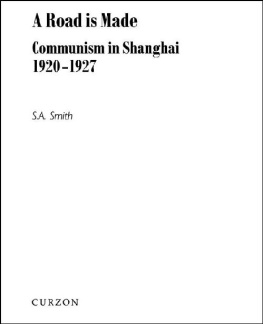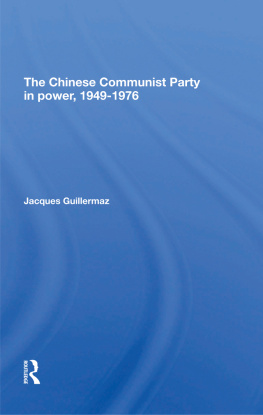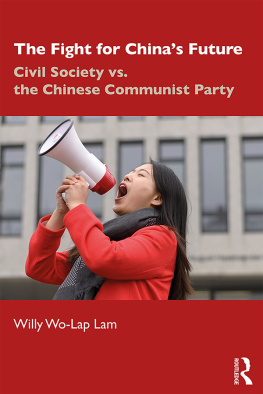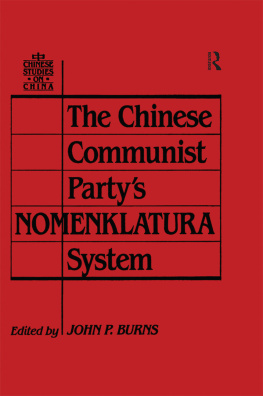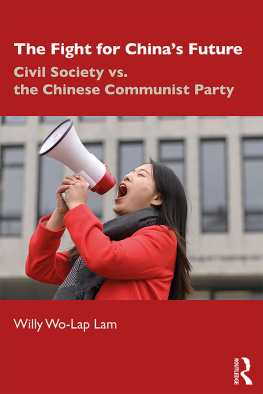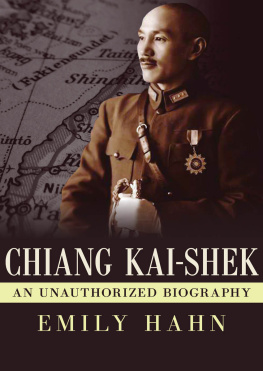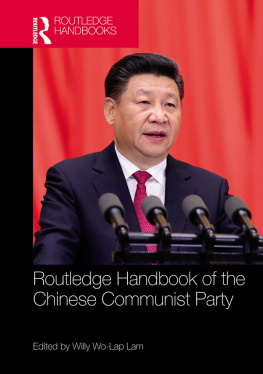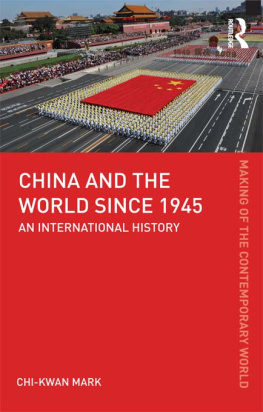A Road is Made
Communism in Shanghai 1920-1927
Chinese Worlds
Chinese Worlds publishes high-quality scholarship, research monographs, and source collections on Chinese history and society from 1900 into the next century.
Worlds signals the ethnic, cultural, and political multiformity and regional diversity of China, the cycles of unity and division through which Chinas modern history has passed, and recent research trends toward regional studies and local issues. It also signals that Chineseness is not contained within territorial borders -overseas Chinese communities in all countries and regions are also Chinese worlds. The editors see them as part of a political, economic, social, and cultural continuum that spans the Chinese mainland, Taiwan, Hong Kong, Macau, South-East Asia, and the world.
The focus of Chinese Worlds is on modern politics and society and history. It includes both history in its broader sweep and specialist monographs on Chinese politics, anthropology, political economy, sociology, education, and the social-science aspects of culture and religions.
The Literary Field of Twentieth-Century China
Edited by Michel Hockx
Chinese Business in Malaysia
Accumulation, Ascendance, Accommodation
Edmund Terence Gomez
Internal and International Migration
Chinese Perspectives
Edited by Frank N. Pieke and Hein Mollee
Village Inc.
Chinese Rural Society in the 1990s
Edited by Flemming Christiansen and Zhang Junzuo
Chen Duxius Last Articles and Letters, 1937-1942
Edited and translated by Gregor Benton
Encyclopedia of the Chinese Overseas
Edited by Lynn Pan
New Fourth Army
Communist Resistance along the Yangtze and the Huai, 1938-1941 Gregor Benton
A Road is Made
Communism in Shanghai 1920-1927 Steve Smith
The Bolsheviks and the Chinese Revolution 1919-1927
Alexander Pantsov
Chinatown, Europe
Identity of the European Chinese
Towards the Beginning of the
Twenty-First Century
Flemming Christiansen
Birth Control in China 1949-1999
Population Policy and Demographic
Development
Thomas Scharping
A Road is Made
Communism in Shanghai 1920-1927
S.A. Smith

First Published in 2000
by Curzon Press
Richmond, Surrey
http://www.curzonpress.co.uk
2000 S.A. Smith
Typeset in Plantin by LaserScript Ltd, Mitcham, Surrey
All rights reserved. No part of this book may be reprinted or reproduced or utilised in any form or by any electronic, mechanical, or other means, now known or hereafter invented, including photocopying and recording, or in any information storage or retrieval system, without permission in writing from the publishers.
British Library Cataloguing in Publication Data
A catalogue record of this book is available from the British Library
ISBN 13: 978-0-7007-1207-6 (hbk)
Hope can neither be affirmed nor denied.
Hope is like a path in the countryside.
Originally, there was no path but when many
people pass one way, a road is made.
Lu XuYiy My Old Home (January 1921)
Contents
I first began work on a study of labour and nationalism in Shanghai longer ago than I care to remember in 1986. The book I then planned to write was designed to shift the focus away from the Chinese Communist Party (CCP), by examining labours relation to the nationalist movement from the turn of the century. However, since scholars in the PRC began to publish a vast amount of material relating to the early years of the CCP during the 1980s, I found myself collecting much more material on the history of the party than I needed for my book. The sudden opening of the Comintern archives to western scholars in 1991, following the collapse of the Soviet Union, made me reconsider my decision not to get involved in the history of the CCP, since my other career as a historian of labour in late-imperial and early Soviet Russia seemed to qualify me to try to integrate the new material on Comintern policy in China most of which was in Russian with the mass of material on the CCP in Shanghai. A visit to Moscow to the former archive of the Communist Party of the Soviet Union (RTsKhlDNI) confirmed that there was a indeed a huge amount of material relating to Comintern operations in China. Fortunately, I was spared the effort of wading through this by the discovery that a team of Russian and German scholars from the Far-Eastern Institute of the Russian Academy of Sciences and the East Asia Seminar of the Free University of Berlin, led, respectively, by Professors M.L. Titarenko and Mechthild Leutner, was already embarked on a massive project to publish all Comintern material relating to China. The first two volumes of their project, covering the years 1920 to 1927, appeared in 1994 and 1996 and greatly eased my work on this book. The result has been that I have ended up writing two books at once: the first is the book I always intended to write on labour and nationalism in Shanghai between 1900 and 1927, which is currently in the final stages of revision, and the second is the present volume which investigates the activities, ideas and internal life of the CCP in Shanghai during its formative years.
In writing this book I have accumulated many debts and I intend simply to list the names of most of those who have helped me. It would be discourteous, however, if I did not single out Greg Benton, formerly of the University of Leeds and now of the University of Cardiff, for giving me warm support and for reading this ms. with characteristic care and insight. In addition, I should like to thank Robert Bickers of the University of Bristol and Julia Strauss of the School of Oriental and African Studies, University of London, who served as exemplary publishers readers, offering astute criticisms and suggestions for improvements. My sometimes flagging enthusiasm for the project was rekindled by invitations to participate in two major conferences, both of which turned out to be unusually stimulating. The first was the Third Medlicott Symposium, which took place in July 1995 at the University of Exeter, which was devoted to the history of the Comintern. I would like to thank Tim Rees and Andrew Thorpe, the organizers, for inviting me and Nina Fishman and Paul Wingrove for being stimulating companions. The second conference took place at the Free University of Berlin in October 1998 and was devoted to New Research and New Perspectives on the Chinese Revolution in the 1920s. Again I would like warmly to thank the organizers, Professor Mechthild Leutner and Dr Tim Trampedach, and Konstantin Shevelev and Alexander Pantsov for sharing with me their matchless knowledge of the Comintern. Other participants from whom I learnt a great deal were Christina Gilmartin, Chen Yung-fa, Yu Minling and Li Yuzhen. Professor A.I. Kartunova deserves a special mention for graciously lending me a chapter of her unpublished doctors dissertation, as does Professor Joachim Krger, who gave me a copy of a rare Chinese poster from his personal collection. Finally, I must thank Elizabeth Perry, then of the University of California at Berkeley, and Hans van de Ven of Cambridge University for generously lending me materials to which I would otherwise not have had access.

